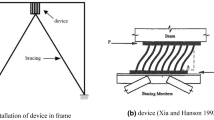Abstract
The usage of the passive energy dissipative system is increasing nowadays in the high seismic risk zones, particularly in the important buildings. In this context, the effectiveness of the nonlinear fluid viscous dampers (FVDs) in the seismic performance enhancement of RC buildings is analysed in this study. This research compares the engineering response parameters such as total displacement, drift ratio, residual displacement and the floor acceleration between bare frame only model and the same with the addition of nonlinear fluid viscous dampers for Design Basis Earthquake (DBE) and Maximum Considered Earthquake (MCE). The study is done in three categories of regular buildings from the perspective of Nepalese cities; five-storeyed, ten-storeyed and fifteen-storeyed buildings as this covers the typical high-rise buildings in Nepal. The building is modelled in the 3-D finite element analysis software SAP2000 developed by Computers and Structures Inc. The results show that nonlinear fluid viscous dampers are highly effective in reducing the storey displacement, drift and residual displacement whereas less effective in reducing floor acceleration as compared to the others and the efficacy of the dampers reduces with increasing building height.









Similar content being viewed by others
References
ASCE 41-13. (2007). Seismic evaluation and retrofit of existing buildings (ASCE 41-13). Seismic Rehabilitation of Existing Buildings. https://doi.org/10.1061/9780784408841.err
ASCE 7-16. (2000). Minimum design loads for buildings and other structures. In ANSI/ASCE Standard (Issue 7 98). https://doi.org/10.1061/9780872629042.
Aydin, E. (2013). A simple damper optimization algorithm for both target added damping ratio and interstorey drift ratio. Earthquake and Structures, 5(1), 83–109. https://doi.org/10.12989/eas.2013.5.1.083
Aydin, E., Farsangi, E. N., Öztürk, B., Bogdanovic, A., & Dutkiewicz, M. (2019). Improvement of building resilience by viscous dampers. Resilient Structures and Infrastructure. Springer Singapore. https://doi.org/10.1007/978-981-13-7446-3
Bilham, R. (1995). Location and Magnitude of the 1833 Nepal Earthquake and its Relation to the Rupture zones of Contiguous Great Himalayan earthquakes.
Cetin, H., Aydin, E., & Ozturk, B. (2019). Optimal design and distribution of viscous dampers for shear building structures under seismic excitations. Frontiers in Built Environment. https://doi.org/10.3389/fbuil.2019.00090
Cheng, Y. (2019). Simulation-Based Evaluation and Optimization of the Seismic Performance of Buildings with Passive Energy Dissipation System. Dissertation. Clemson University.
Comission(NPC), N. planning. (2015). Nepal Earthquake 2015—Post disaster needs assessment. Vol. B: Sector Reports. 20. http://www.worldbank.org/content/dam/Worldbank/document/SAR/nepal-pdna-executive-summary.pdf
Del Gobbo, G. M., Blakeborough, A., & Williams, M. S. (2018). Improving total-building seismic performance using linear fluid viscous dampers. Bulletin of Earthquake Engineering, 16(9), 4249–4272. https://doi.org/10.1007/s10518-018-0338-4
Gherbi, A., & Belgasmia, M. (2018). Use of fluid viscous dampers in structural control: A case study. International Journal of Forensic Engineering, 4(2), 119. https://doi.org/10.1504/ijfe.2018.10019980
Kim, D., Sung, E. H., Park, K., & Park, J. (2014). Evaluation of Seismic Performance and Effectiveness of Multiple Slim-Type Damper System for Seismic Response Control of Building Structures
Kramer, S. L. (1996). Geotechnical Earthquake Engineering. NJ: Prentice-Hall.
Miyamoto, H. K., Gilani, A. S., & Wada, A. (2012). The effectiveness of viscous dampers for structures subjected to large earthquakes. In 15th World Conf. Earthq. Eng.
National Reconstruction Authority. (NBC 105: 2020). Seismic design of buildings in Nepal. Ministry of Urban Development, 1–111.
Pandey, M. R., Tandukar, R. P., Avouac, J. P., Lavé, J., & Massot, J. P. (1995). Interseismic strain accumulation on the Himalayan crustal ramp (Nepal). Geophysical Research Letters, 22(7), 751–754. https://doi.org/10.1029/94GL02971
Takewaki, I. (2000). Optimal damper placement for planar building frames using transfer functions. Structural and Multidisciplinary Optimization, 20(4), 280–287. https://doi.org/10.1007/s001580050158
Uz, M. E., & Hadi, M. N. S. (2009). Dynamic analyses of adjacent buildings connected by fluid viscous dampers. WIT Transactions on the Built Environment, 104, 139–150. https://doi.org/10.2495/ERES090131
Acknowledgements
The authors acknowledge the American Society of Nepalese Engineers for their financial as well as technical support for the preparation of this paper.
Funding
The American Society of Nepalese Engineers provided funding for this study.
Author information
Authors and Affiliations
Contributions
PB, PT and RS contributed equally in preparing the conceptual framework, carrying out the research, to the analysis of the results, discussion and validation of the results, and preparation of the manuscript.
Corresponding author
Ethics declarations
Conflicts of interest
The authors declare that they have no conflict of interest.
Additional information
Publisher's Note
Springer Nature remains neutral with regard to jurisdictional claims in published maps and institutional affiliations.
Rights and permissions
Springer Nature or its licensor holds exclusive rights to this article under a publishing agreement with the author(s) or other rightsholder(s); author self-archiving of the accepted manuscript version of this article is solely governed by the terms of such publishing agreement and applicable law.
About this article
Cite this article
Tiwari, P., Badal, P. & Suwal, R. Effectiveness of fluid viscous dampers in the seismic performance enhancement of RC buildings. Asian J Civ Eng 24, 309–318 (2023). https://doi.org/10.1007/s42107-022-00504-1
Received:
Accepted:
Published:
Issue Date:
DOI: https://doi.org/10.1007/s42107-022-00504-1




